
Newfoundland, Canada
One of the things I love about Newfoundland is how close you can be to wild-growing plants in their natural habitats, even if you live downtown in the province’s largest city. A five-minute walk from the commercial heart of the province I found an abundance of Newfoundland’s most common native wildflowers and shrubs. I also got a taste of common Newfoundland weather – an hour and a half saw the weather switch from warm and sunny to drizzly and foggy and back again. On a day trip to the southern shore, meanwhile, the sky was clear and blue when we set out, but by the end of our afternoon walk to an abandoned lighthouse, the sky had turned foggy grey and the coastal winds almost blew us over.
Labrador Tea (Ledum groenlandium)
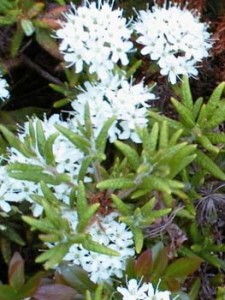
A low-lying shrub found everywhere in Newfoundland. On a walk out to a lighthouse on the southern shore, we found lots of these plants growing along the trail and in the rocky barrens around us. As its name suggests, the leathery leaves can be crushed and boiled into a tea, which was traditionally used in outport fishing communities for its medicinal properties.
Sheep laurel (Kalmia angustifolia)
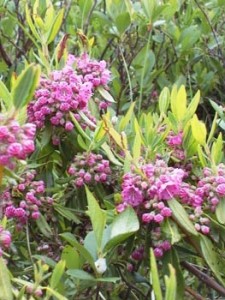
In the same family (ericaceae) is the bright-pink-flowered Sheep Laurel. It is as common on the barrens as Labrador tea, and adds a splash of colour to terrain dominated by grasses, rock, and lichens. I’m always surprised at how something so striking can grow out of what looks like solid rock. I took this picture walking up Signal Hill in downtown St. John’s.
Garden lupine (Lupinus polyphyllus)
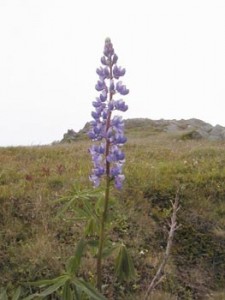
A native Newfoundland plant which has become as ubiquitous as the non-native dandelion. Driving ‘out the highway,’ lupines are visible all along the sides of the roads, in ditches and fields and on front lawns. I took this picture against the foggy sky just after a light drizzle, on my walk up Signal Hill.
Bog cotton (Eriophorum angustifolium)
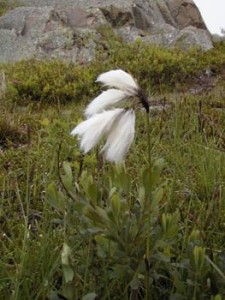
Grows in waving, windblown masses in the kind of terrain its name suggests – boggy, marshy, muddy and wet. It took me awhile to get a good photograph on such a windy day.
Simple tea (Potentilla tridentata)
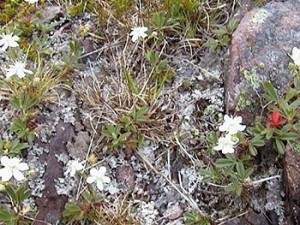
Grows well in Newfoundland’s rocky terrain, and I saw it everywhere as I walked around Signal Hill. Its tiny white flowers grow on stalks around 3 inches long, and its low, dark green leaves turn deep red in the fall.
Harebell (Campanula rotundifolia)
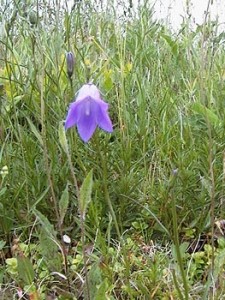
The delicate purple of this single flower caught my eye as I walked back down the Hill towards the city. It must be an early bloom, because it grew surrounded by unopened buds.
Partridgeberry (Vaccinium vitis idaea)
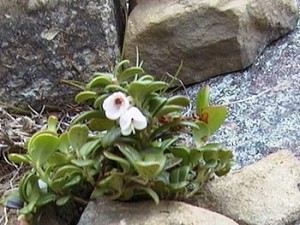
A wild shrub popular for the tart red berries it produces in the fall. It normally grows in large clumps with dozens of nodding pink flowers, but I loved this tiny little plant growing alone between two rocks, reminding me of the partridgeberry pancakes I had eaten for breakfast.
Blue Flag Iris (Iris versicolor)
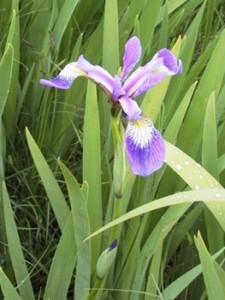
I was surprised when I learned that this is only one of many varieties native to Newfoundland. Its showy flowers somehow seem too vulnerable for Newfoundland’s climate, especially when they grow surrounded by more hardy-seeming specimens like Labrador tea and sheep laurel. I found a large clump of irises thriving in a marshy portion of the Signal Hill walk.
Sea thrift (Plumbaginaceae armeria maritima)
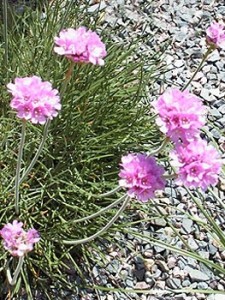
Common throughout Canada’s East Coast. It loves rocks, too, and the white and pink varieties can be found both in the wild and in rock gardens.
Twinflower (Linnaea borealis)
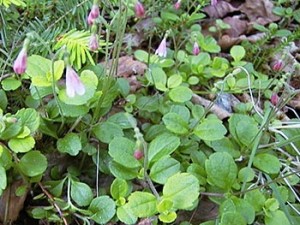
I love this delicate, symmetrical flower. I took this picture in the wild, the plant growing in the shadow of some small spruce trees. It’s actually the symbol of the Newfoundland Botanical Gardens, but when I visited, their specimens weren’t in bloom.
Fair Maids of France (Ranunculus aconitifolius pleniflorus)
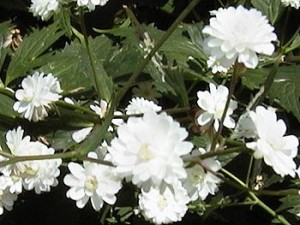
The importance of this plant was impressed upon me several times during my visit. A hundred years ago, it would have been one of the few flowers in nearly all the gardens of Newfoundland outports, but today it relies on the Newfoundland Botanical Gardens to help it survive.
I was hoping to include a photo of the elusive insectivorous Pitcher Plant (Newfoundland’s provincial flower), but I couldn’t find one. Here instead is an expanse of tall grass and buttercups blowing in the wind by the sea.